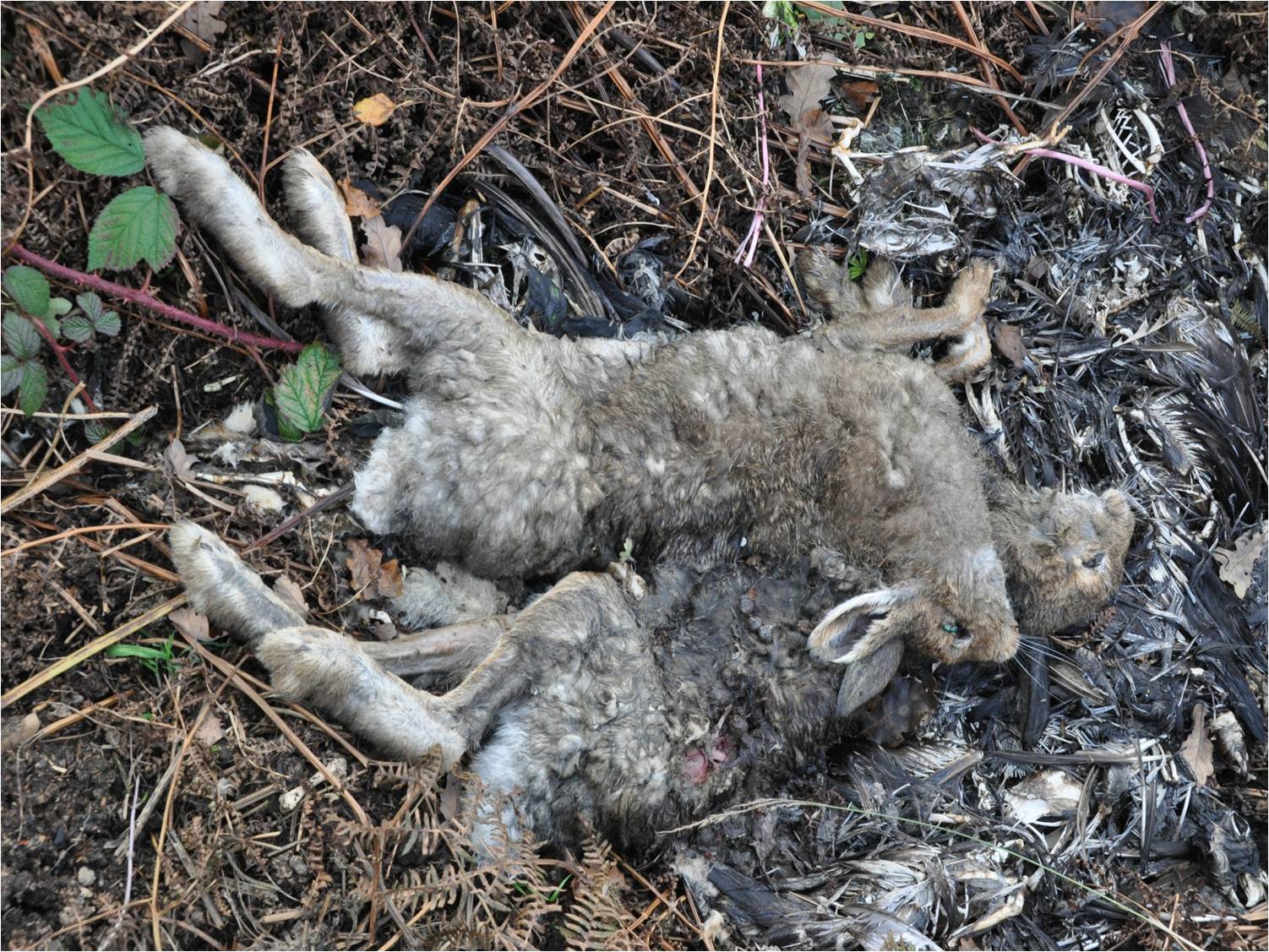
If this image of dead Mountain Hares lying in a gamekeeper’s stink pit upsets you, then please remember that this type of thing is going on in our National Parks wherever driven grouse shooting bumps up against Mountain Hares and make your views known through this website on the future of our National Parks.
You could also sign this e-petition asking Scottish ministers to protect the Mountain Hare.
[registration_form]
Interesting parallel between the recent pictures of a pile of dead mountain hares in the back of a pick up which have been sanctioned as a ‘sustainable harvest’ by Bert Burnett and others of that ilk with the derision and very public attacks the same people made on the John Muir Trust for a red deer cull it conducted on Knoydart that killed 86 animals over a three and a half month period ttp://www.scotsman.com/news/environment/gamekeepers-angered-by-john-muir-trust-deer-cull-1-3982843. This constituted a massacre apparently. The main phoney grievance was that apart from a few cuts of meat most of the venison had to be left on the hill, JMT claims and I believe them that the areas the deer were shot were relatively inaccessible and the carcasses couldn’t be brought out. As the deer would have been eaten by eagles, foxes etc and naturally recycled in my book this does not constitute real waste as it didn’t go to landfill, but does mean fewer starving deer on the hills and more trees to give them cover in the future. However, the Scottish Gamekeepers Association rather ludicrously gave this as an example of waste when people are having to use foodbanks. I wonder how outraged they are at the amount of food thrown out by supermarkets, restaurants, pubs and the general householder each year? So I can only assume that those hares killed for whatever reason are at least redistributed to the local needy by those socially conscious estates and their kindly employees, that’s what Bert must have meant when he spoke about harvesting, surely they wouldn’t be getting used as poisoned bait or thrown in a stinkpit? Bert and buddies would be tremendous hypocrites if that were the case. Perhaps they’d let us know what happened to all that good quality meat that wasn’t difficult to remove as after all it’s already in the back of a vehicle. I’ve got the kleenex ready to wipe away the tears as we hear of how those poor, misunderstood keepers put the Salvation Army to shame by taking hare pie/casserole/roast to lonely old folks, homeless hostels, foodbanks and give it to the schools so that their pupils can have it for dinner, the ‘gift of hare’.
I appreciate that deer do sometimes need to be killed Les – but why not also consider non lethal means of control like walking dogs around areas to disperse them by flushing?
Why should that be a wildlife crime?
I don’t think stationing people and their dogs at strategic positions throughout the Scottish highlands and borders on a pretty much 24/7 basis to chase deer away from young trees would prove practical. Perhaps an occasional little scare won’t do a deer much harm, but it won’t be fun for it either. Deer being regularly chased must go through a lot of stress and occasional injury. I know that our local rangers repeatedly come across incidents where the darling public think it’s ok for dear Fido to have some exercise chasing a deer as ‘they’ll never catch it’. When I was younger I toyed with the idea of being trained in deer stalking, not because I wanted too, but because it needs to be done and to me it was a job unfair to leave to other people. I hate the idea of culling, but know it just has to be done.
Agree and thanks for the link where I spotted this good comment by SLIOCH:
1:07 PM on 23/12/2015 in the Scotsman.
‘’…. Removing the carcases of deer from the hills results in further depletion of calcium and phosphorous (mainly in the bones of the animal) and denies sustenance for predators and scavengers, like golden eagles.
THE John Muir Trust has helped restore native woodlands over much of its land in Knoydart, thus helping to protect and restore soils, reduce flooding and erosion, and provide food for invertebrates, which in turn feed small birds and mammals. In short, reducing deer numbers and re-establishing native woodland helps to restore the health and vitality of the whole area.
…..Leaving deer carcases on the hill is part of that realisation that we need to look after and nurture the natural world and not always insist on taking, taking, taking, and giving nothing back.
The JMT are to be congratulated for coming to this realisation…..’’
Read more: http://www.scotsman.com/news/environment/gamekeepers-angered-by-john-muir-trust-deer-cull-1-3982843#ixzz433cT7rey
Follow us: @TheScotsman on Twitter | TheScotsmanNewspaper on Facebook
I would only add that Scottish Red Deer are on average smaller than their European counterparts living in natural forests. We tend to forget that this species is a woodland animal not an open moorland one.
Yes good ole Bert Burnett is doing his best to say that Scottish deer are naturally smaller due to inclement weather, he compares them with Scottish domestic breeds which are generally Wee. Doubt that their present small stature is purely down to the Scottish non summer. Be really good to compare sizes with red deer in Norway which have decent stands of woodland to breed and feed in. The self delusion this lot wallow in is unbelievable.